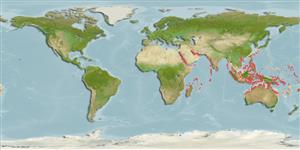Common names from other countries
>
Eupercaria/misc (Various families in series Eupercaria) >
Scaridae (Parrotfishes) > Scarinae
Etymology: Hipposcarus: Greek, ippos = horse + Latin, scarus = a fish cited by ancient writers; 1601 (Ref. 45335).
Environment: milieu / climate zone / depth range / distribution range
Écologie
marin récifal; non migrateur; profondeur 1 - 25 m (Ref. 9710). Tropical
Western Indian Ocean: Red Sea south to Mozambique Channel, including Madagascar and Seychelles and east to Sri Lanka, Maldives and the Chagos Archipelago. Occurrence in Java, Indonesia as reported by Ref. 9710 needs verification.
Taille / Poids / Âge
Maturity: Lm ? range ? - ? cm
Max length : 75.0 cm TL mâle / non sexé; (Ref. 5490); common length : 35.0 cm TL mâle / non sexé; (Ref. 5450); poids max. publié: 2.3 kg (Ref. 3488)
Inhabits coastal regions associated with coral reefs and reef flats. Forms groups consisting of a terminal phased individual and numerous individuals in the initial phase (Ref. 9710). Feeds on benthic algae (Ref. 30573). Caught with nets and other artisanal gear. Mainly sold fresh.
Life cycle and mating behavior
Maturité | Reproduction | Frai | Œufs | Fécondité | Larves
Oviparous, distinct pairing during breeding (Ref. 205).
Bruce, R.W. and J.E. Randall, 1984. Scaridae. In W. Fischer and G. Bianchi (eds.) FAO species identification sheets for fishery purposes. (Western Indian Ocean fishing area 51). volume 3. [var. pag.] FAO, Rome. (Ref. 3488)
Statut dans la liste rouge de l'IUCN (Ref. 130435)
CITES (Ref. 128078)
Not Evaluated
Menace pour l'homme
Harmless
Utilisations par l'homme
Pêcheries: commercial; Aquarium: Commercial
Plus d'informations
RéférencesAquacultureProfil d'aquacultureSouchesGénétiqueElectrophoresesHéritabilitéPathologiesTraitementMass conversion
Outils
Articles particuliers
Télécharger en XML
Sources Internet
Estimates based on models
Preferred temperature (Ref.
115969): 25.2 - 29.3, mean 28.5 (based on 3110 cells).
Phylogenetic diversity index (Ref.
82804): PD
50 = 0.7500 [Uniqueness, from 0.5 = low to 2.0 = high].
Bayesian length-weight: a=0.01318 (0.00842 - 0.02064), b=2.98 (2.85 - 3.11), in cm Total Length, based on LWR estimates for this species & (Sub)family-body (Ref.
93245).
Niveau trophique (Ref.
69278): 2.0 ±0.00 se; based on food items.
Résilience (Ref.
120179): Faible, temps minimum de doublement de population : 4,5 à 14 années (Preliminary K or Fecundity.).
Fishing Vulnerability (Ref.
59153): Moderate to high vulnerability (51 of 100).
